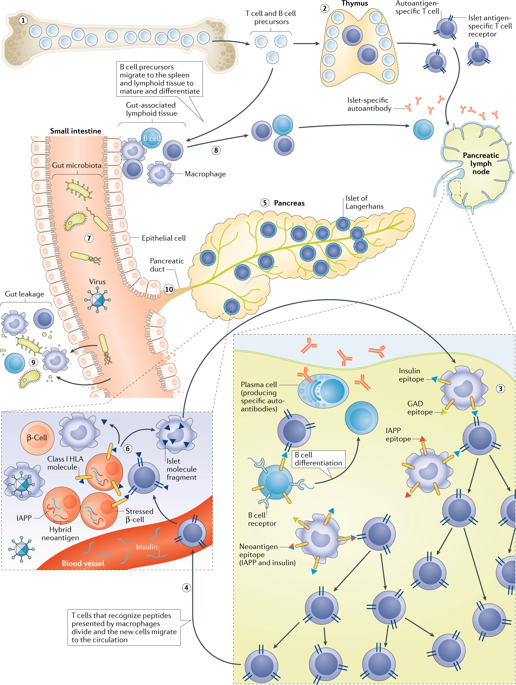当前位置:
X-MOL 学术
›
Nat. Rev. Endocrinol.
›
论文详情
Our official English website, www.x-mol.net, welcomes your
feedback! (Note: you will need to create a separate account there.)
The heterogeneous pathogenesis of type 1 diabetes mellitus.
Nature Reviews Endocrinology ( IF 31.0 ) Pub Date : 2019-09-18 , DOI: 10.1038/s41574-019-0254-y Jorma Ilonen 1 , Johanna Lempainen 1, 2 , Riitta Veijola 3
Nature Reviews Endocrinology ( IF 31.0 ) Pub Date : 2019-09-18 , DOI: 10.1038/s41574-019-0254-y Jorma Ilonen 1 , Johanna Lempainen 1, 2 , Riitta Veijola 3
Affiliation

|
Type 1 diabetes mellitus (T1DM) results from the destruction of pancreatic β-cells that is mediated by the immune system. Multiple genetic and environmental factors found in variable combinations in individual patients are involved in the development of T1DM. Genetic risk is defined by the presence of particular allele combinations, which in the major susceptibility locus (the HLA region) affect T cell recognition and tolerance to foreign and autologous molecules. Multiple other loci also regulate and affect features of specific immune responses and modify the vulnerability of β-cells to inflammatory mediators. Compared with the genetic factors, environmental factors that affect the development of T1DM are less well characterized but contact with particular microorganisms is emerging as an important factor. Certain infections might affect immune regulation, and the role of commensal microorganisms, such as the gut microbiota, are important in the education of the developing immune system. Some evidence also suggests that nutritional factors are important. Multiple islet-specific autoantibodies are found in the circulation from a few weeks to up to 20 years before the onset of clinical disease and this prediabetic phase provides a potential opportunity to manipulate the islet-specific immune response to prevent or postpone β-cell loss. The latest developments in understanding the heterogeneity of T1DM and characterization of major disease subtypes might help in the development of preventive treatments.
中文翻译:

1型糖尿病的异质发病机制。
1型糖尿病(T1DM)是由免疫系统介导的胰岛β细胞破坏引起的。T1DM的发展涉及个体患者可变组合中发现的多种遗传和环境因素。遗传风险是由特定等位基因组合的存在来定义的,这些等位基因组合在主要的易感基因座(HLA区域)中会影响T细胞的识别以及对异源和自体分子的耐受性。多个其他基因座也调节和影响特异性免疫反应的特征,并改变β细胞对炎性介质的脆弱性。与遗传因素相比,影响T1DM发育的环境因素的特征较差,但与特定微生物的接触正成为重要的因素。某些感染可能会影响免疫调节,而共生微生物(例如肠道菌群)的作用对于发展中的免疫系统至关重要。一些证据还表明营养因素很重要。在临床疾病发作之前的几周到20年内,循环中发现了多种胰岛特异性自身抗体,并且该糖尿病前期期提供了操纵胰岛特异性免疫反应以预防或推迟β细胞丢失的潜在机会。了解T1DM异质性和表征主要疾病亚型的最新进展可能有助于预防性治疗的发展。一些证据还表明营养因素很重要。在临床疾病发作之前的几周到20年内,循环中发现了多种胰岛特异性自身抗体,并且该糖尿病前期期提供了操纵胰岛特异性免疫反应以预防或推迟β细胞丢失的潜在机会。了解T1DM异质性和表征主要疾病亚型的最新进展可能有助于预防性治疗的发展。一些证据还表明营养因素很重要。在临床疾病发作之前的几周到20年内,循环中发现了多种胰岛特异性自身抗体,并且该糖尿病前期期提供了操纵胰岛特异性免疫反应以预防或推迟β细胞丢失的潜在机会。了解T1DM异质性和表征主要疾病亚型的最新进展可能有助于预防性治疗的发展。在临床疾病发作之前的几周到20年内,循环中发现了多种胰岛特异性自身抗体,并且该糖尿病前期期提供了操纵胰岛特异性免疫反应以预防或推迟β细胞丢失的潜在机会。了解T1DM异质性和表征主要疾病亚型的最新进展可能有助于预防性治疗的发展。在临床疾病发作之前的几周到20年内,在循环中发现了多种胰岛特异性自身抗体,并且该糖尿病前期期提供了操纵胰岛特异性免疫反应以预防或推迟β细胞丢失的潜在机会。了解T1DM异质性和表征主要疾病亚型的最新进展可能有助于预防性治疗的发展。
更新日期:2019-09-18
中文翻译:

1型糖尿病的异质发病机制。
1型糖尿病(T1DM)是由免疫系统介导的胰岛β细胞破坏引起的。T1DM的发展涉及个体患者可变组合中发现的多种遗传和环境因素。遗传风险是由特定等位基因组合的存在来定义的,这些等位基因组合在主要的易感基因座(HLA区域)中会影响T细胞的识别以及对异源和自体分子的耐受性。多个其他基因座也调节和影响特异性免疫反应的特征,并改变β细胞对炎性介质的脆弱性。与遗传因素相比,影响T1DM发育的环境因素的特征较差,但与特定微生物的接触正成为重要的因素。某些感染可能会影响免疫调节,而共生微生物(例如肠道菌群)的作用对于发展中的免疫系统至关重要。一些证据还表明营养因素很重要。在临床疾病发作之前的几周到20年内,循环中发现了多种胰岛特异性自身抗体,并且该糖尿病前期期提供了操纵胰岛特异性免疫反应以预防或推迟β细胞丢失的潜在机会。了解T1DM异质性和表征主要疾病亚型的最新进展可能有助于预防性治疗的发展。一些证据还表明营养因素很重要。在临床疾病发作之前的几周到20年内,循环中发现了多种胰岛特异性自身抗体,并且该糖尿病前期期提供了操纵胰岛特异性免疫反应以预防或推迟β细胞丢失的潜在机会。了解T1DM异质性和表征主要疾病亚型的最新进展可能有助于预防性治疗的发展。一些证据还表明营养因素很重要。在临床疾病发作之前的几周到20年内,循环中发现了多种胰岛特异性自身抗体,并且该糖尿病前期期提供了操纵胰岛特异性免疫反应以预防或推迟β细胞丢失的潜在机会。了解T1DM异质性和表征主要疾病亚型的最新进展可能有助于预防性治疗的发展。在临床疾病发作之前的几周到20年内,循环中发现了多种胰岛特异性自身抗体,并且该糖尿病前期期提供了操纵胰岛特异性免疫反应以预防或推迟β细胞丢失的潜在机会。了解T1DM异质性和表征主要疾病亚型的最新进展可能有助于预防性治疗的发展。在临床疾病发作之前的几周到20年内,在循环中发现了多种胰岛特异性自身抗体,并且该糖尿病前期期提供了操纵胰岛特异性免疫反应以预防或推迟β细胞丢失的潜在机会。了解T1DM异质性和表征主要疾病亚型的最新进展可能有助于预防性治疗的发展。










































 京公网安备 11010802027423号
京公网安备 11010802027423号